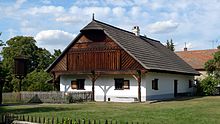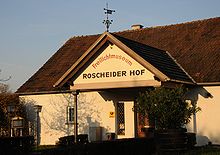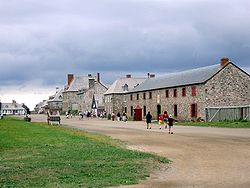- Open-air museum
-
An open-air museum is a distinct type of museum exhibiting its collections out-of-doors. The first open-air museums were established in Scandinavia towards the end of the nineteenth century, and the concept soon spread throughout Europe and North America. Open-air museums are variously known as skansen, museums of buildings and folk museums. A more recent form is the Ecomuseum, which originated in France. A comprehensive history of the open-air museum as idea and institution can be found in Swedish museologist Sten Rentzhog's 2007 book Open Air Museums: The History and Future of a Visionary Idea.
Living museums, also known as living farm museums and living history museums, are a special type of open-air museum where costumed interpreters portray period life in an earlier era. The interpreters act as if they are really living in a different time and place, such as the Colonial era, and perform everyday household tasks, crafts and businesses. The goal is to demonstrate older lifestyles to modern audiences. Household tasks might include cooking on an open hearth, churning butter, spinning wool and weaving, and farming without modern equipment. Many living museums feature traditional craftsmen at work, such as a blacksmith, cooper, potter, miller, sawmill worker, printer, doctor and general store keeper.
Definition
The International Council of Museums (ICOM) defines a museum as "a non-profit-making, permanent institution in the service of society and of its development, open to the public, which acquires, conserves, researches, communicates and exhibits, for purposes of study, education and enjoyment, the tangible and intangible evidence of people and their environment."[1] Most open-air museums specialize in the collection and re-erection of old buildings at large outdoor sites, usually in settings of re-created landscapes of the past. Most of them may therefore justly be described as building museums. Open-air museums tended to be located originally in regions where wooden architecture prevailed, as wooden structures may be trans-located without substantial loss of authenticity.
Common to all open-air museums, including the earliest ones of the 19th century, is the teaching of the history of everyday living by people from all segments of society.
European origins
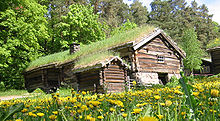 Old log houses at the Norsk Folkemuseum, Oslo.
Old log houses at the Norsk Folkemuseum, Oslo.
The earliest open-air museum appeared in Scandinavia in the late 19th century. One reason may be the ancient tradition of moving and re-erecting wooden buildings, based on the local log building technique. The idea was a predictable further development of the by then well-established indoor type of museum. In order to collect and display whole buildings, it would have to be done outdoors. Precursors of open-air museums were the "exotic" pavilions, "antique" temples, "ancient ruins" and "peasant cottages" to be found in 18th century landscape parks. Later precursors were the real or constructed peasant cottages shown at the international exhibitions of the mid- to-late 19th century.
The world's first open-air museum was King Oscar II's collection near Oslo in Norway, opened in 1881. The original plans comprised 8 or 10 buildings intended to show the evolution of traditional Norwegian building types since the Middle Ages. Only 5 were realized before the king lost interest because of the expenses involved. The royal open-air museum was later incorporated into the Norsk Folkemuseum, established on an adjacent property in the 1890s.[2] Influenced by a visit to the Norwegian open-air museum, Artur Hazelius in 1891 founded the famous Skansen in Stockholm, which became the model for subsequent open-air museums in Northern and Eastern Europe, and eventually in other parts of the world. The name "skansen" has also been used as a noun to refer to other open-air museums and collections of historic structures, particularly in Central and Eastern Europe.[3]
Around 1900, national and regional open-air museums were established in all Scandinavian countries, notably in Norway and Sweden.
Most open-air museums concentrate on rural culture. However, since the opening of the first town museum, Den Gamle By/The Old Town in Aarhus, Denmark in 1914,[4] town culture has also become a scope of open-air museums. In many cases new town quarters are being constructed in existing rural culture museums.
North American interpretation
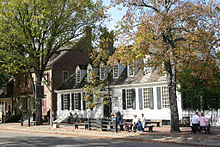 Traditional buildings in Colonial Williamsburg
Traditional buildings in Colonial Williamsburg
The North American open-air museum, more commonly called a living history museum, had a different, slightly later origin than the European, and the visitor experience is different. The first was Henry Ford's Greenfield Village in Dearborn, Michigan (1928), where Ford intended his collection to be "a pocket edition of America".[5] But it was Colonial Williamsburg (opened in 1934) which had a greater influence on museum development in North America. It influenced such projects through the continent as Mystic Seaport, Plimoth Plantation, and Fortress Louisbourg. What tends to differentiate the North American from the European model is the approach to interpretation. In Europe, the tendency is to usually, but not always, focus on the building.
In North America, many open-air museums include interpreters who dress in period costume and conduct period crafts and everyday work.[6] The living museum is therefore viewed as an attempt to recreate to the fullest extent conditions of a culture, natural environment or historical period. The objective is total immersion, using exhibits so that visitors can experience the specific culture, environment or historical period using all the physical senses. Performance and historiographic practices at American living museums have been critiqued in the past several years by scholars in anthropology and theater for creating false senses of authenticity and accuracy, and for neglecting to bear witness to some of the darker aspects of the American past (e.g., slavery and other forms of injustice). Even before such critiques were published, sites such as Williamsburg and others had begun to add more interpretation of difficult history.[7]
Selected list of open-air and living museums
Africa
Egypt
- The Pharaonic Village, Cairo
- Memphis ruins
Asia
Israel
- Katzrin Ancient Village
- Nazareth Village
Japan
- Edo-Tokyo Open Air Architectural Museum, Tokyo
- Hakone Open-Air Museum, Hakone, Kanagawa
- Meiji Mura, Inuyama, Aichi
- Nihon Minka-en (Japan Open-Air Folk House Museum), Kawasaki, Kanagawa
- Open-Air Museum of Old Japanese Farmhouses, Osaka
- Hida Minzoku Mura Folk Village, Takayama, Gifu
- Kyodo no mori, Fuchū, Tokyo
- Sankeien, Naka Ward, Yokohama
- Shikoku Mura, Takamatsu, Kagawa Prefecture
China
Indonesia
South Korea
- Korean Folk Village, Yongin, Gyeonggi
Malaysia
- Colmar Tropicale, Bukit Tinggi, Pahang
- Japanese Village, Bukit Tinggi, Pahang
- Monsopiad Cultural Village. Penampang, Sabah
- Sarawak Cultural Village, Kuching, Sarawak
- Taman Mini Malaysia & Asean (Malaysia and Asean Miniature Park), Ayer Keroh, Malacca
- Taman Tamadun Islam (Islamic Civilization Park), Kuala Terengganu, Terengganu
Europe
 The wooden church in Drvengrad open-air museum, Serbia
The wooden church in Drvengrad open-air museum, Serbia
Austria
- Austrian Open-Air Museum, Stübing
- Salzburger Freilichtmuseum, Großgmain
- Carinthian Open-Air Museum, Maria Saal
- Museums of Tyrolian Farmsteads, Kramsach
- Museumsdorf Niedersulz
Belgium
- Open Air Museum Bokrijk, Flanders, Belgium, http://www1.limburg.be/bokrijk/html/domeinbokrijk.html
- Bachten de Kuppe (Itzenberge), (Flanders), (Belgium), http://www.bachtendekupe.net/
- Fourneau St Michel (Ardennes), (Wallonie), http://www.fourneausaintmichel.be/page/mvisvir.php
Bulgaria
Czech Republic
Old Bohemian House in Přerov nad Labem, Czech Republic – the first open-air museum in Central and Eastern Europe (1895) founded by Archduke Ludwig Salvator
- Hanácký skanzen (Skanzen of the Haná Region), Příkazy
- Museum lidových staveb (Folk Buildings Museum), Kouřim
- Polabské národopisné muzeum (Ethnographic Museum of the region of Polabí), Přerov nad Labem—the oldest skansen in Central and Eastern Europe
- Valašské národopisné muzeum (Valachian Ethnographic Museum), Rožnov pod Radhoštěm
- Skanzen Vysoký Chlumec, (http://www.muzeum-pribram.cz/exhmpb/exmvs/exmvs.html)
Denmark
- Land of legends (Sagnlandet Lejre), Lejre
- The Middle Ages Center in Sundby a suburb of Nykøbing Falster
- The Old Village, Hjerl Hede, Vinderup
- The Old Town, Aarhus
- Open Air Museum (Kongens Lyngby)
- The Funen Village in the Fruens Bøge district of Odense
- Glud Museum, near Horsens
Estonia
- Estonian Open Air Museum in Rocca al Mare, Tallinn
- Viimsi Open Air Museum in Pringi, Viimsi Parish; near Tallinn
Finland
France
- Musée de plein air des maisons comtoises, Nancray, Doubs, Franche-Comté [1]
- Musée de plein air, Villeneuve d'Ascq
- fr:Musée de plein air de Villeneuve-d'Ascq
Germany
- Dat ole Huus, Wilsede, Lower Saxony.
- Open-air Museum Detmold, Detmold, North Rhine-Westphalia Germany's biggest Open-air Museum
- Hagen Westphalian Open-Air Museum, Hagen, North Rhine-Westphalia
- Hessenpark, Neu-Anspach, Hesse.
- Hitzacker Archaeological Centre, Hitzacker, Lower Saxony.
- Hösseringen Museum Village, Hösseringen, Lower Saxony.
- International Wind- and Watermill Museum, Gifhorn, Lower Saxony.
- Open-air Museum Kommern, Mechernich, North Rhine-Westphalia
- Open-air Museum Lindlar, Lindlar, North Rhine-Westphalia
- Mödlareuth village, Bavaria and Thuringia.
- Rischmannshof Heath Museum, Walsrode, Lower Saxony.
- Roscheider Hof, Konz, Rhineland-Palatinate.
- Winsen Museum Farm, Winsen (Aller), Lower Saxony.
- Ore Mountain Toy Museum, Seiffen, Saxony
Georgia
Hungary
- Szentendrei Szabadtéri Néprajzi Múzeum, Szentendre [2]
- Szennai Szabadtéri Néprajzi Gyűjtemény, Szenna
- Göcseji Falumúzeum, Zalaegerszeg
- Őrségi Népi Műemlékegyüttes, Szalafő-(Pityerszer)
- Szabadtéri Néprajzi Múzeum, Ópusztaszer
- Sóstói Múzeumfalu, Nyíregyháza
- Vasi Múzeumfalu, Szombathely
- Hollókői Falumúzeum, Hollókő
- Szabadtéri Néprajzi Múzeum, Nagyvázsony
- Szabadtéri Néprajzi Múzeum, Tihany
Iceland
Ireland
Lithuania
Main article: Ethnographic villages in LithuaniaMacedonia
- Tumba Madžari
Netherlands
- Netherlands Open Air Museum, Arnhem
- Orvelte
- Zuiderzeemuseum, Enkhuizen
- Historisch Openlucht Museum Eindhoven - HOME
- Archeon
Norway
- Norsk Folkemuseum, Oslo
- Maihaugen, Lillehammer
- Trøndelag folkemuseum, Sverresborg. Trondheim
Poland
- Biskupin Archaeological Museum
- Ethnographic open-air museum in Sanok
- Folk Architecture Museum in Olsztynek [3]
- Museum of the Slovinian Village in Kluki [4]
- Muzeum Etnograficzny w Zielonej Górze z siedzibą w Ochlii in Ochla, Lubusz Voivodeship
- Muzeum Kultury Ludowej in Osiek nad Notecią
- Open-air Museum of the Łódź Wooden Architecture
- Skansen Budownictwa Ludowego Zachodniej Wielkopolski in Wolsztyn [5]
- Skansen Etnograficzny w Russowie in Russów [6]
- Upper Silesian Ethnographic Park in Chorzów
- Wielkopolski Park Etnograficzny in Dziekanowice [7]
- Chabówka Rolling-Stock Heritage Park "Skansen" in Chabówka
- The Sądecki Ethnographic Park in Nowy Sącz
Romania
Russia
 Architectural-ethnographic museum "Khokhlovka", Perm Krai
Architectural-ethnographic museum "Khokhlovka", Perm Krai
- Kizhi
- Kolomenskoye
- Architectural-ethnographic museum "Khokhlovka"
Serbia
- Drvengrad (Mećavnik, Küstendorf), Mokra Gora (Zlatibor)
- Staro selo (Old Village open-air museum), Sirogojno (Zlatibor)
Slovakia
Template:Main:Open-air museums in Slovakia
- Banská Štiavnica
- Bardejov
- Čičmany
- Humenné
- Martin
- Nitra
- Pribylina
- Stará Ľubovňa
- Svidník
- Vlkolínec
- Vychylovka
- Zuberec – Brestová
Spain
Sweden
Switzerland
Ukraine
- Lviv Museum of Folk Architecture and Culture (see Kryvka Church)
- Open air Museum of Architecture and Ethnography in Pyrohiv, near Kiev
United Kingdom
England
- Avoncroft Museum of Historic Buildings, Worcestershire
- Amberley Working Museum, Amberley, West Sussex
- Beamish, North of England Open Air Museum, Beamish, County Durham
- Black Country Living Museum, Dudley, West Midlands
- Blists Hill Victorian Town, Telford, Shropshire
- Chiltern Open Air Museum, Chalfont St. Giles, Buckinghamshire
- Church Farm Museum, Agricultural museum and collection of indigenous buildings, Skegness
- Cogges Manor Farm Museum, Witney, Oxfordshire
- Little Woodham, Gosport, Hampshire
- Murton Park / Yorkshire Museum of Farming in Murton, York
- Museum of East Anglian Life, Stowmarket, Suffolk
- Rural Life Centre, Tilford, Surrey
- Weald and Downland Open Air Museum, Sussex
- West Yorkshire Folk Museum, in grounds of Shibden Hall, Halifax
- Wimpole Home Farm, Cambridgeshire
Scotland
Wales
Northern Ireland
- Ulster Folk & Transport Museum, Cultra, Hollywood, Northern Ireland
North America
Canada
- Barkerville, British Columbia
- Black Creek Pioneer Village, Toronto, Ontario
- Burnaby Village Museum, Burnaby, British Columbia
- Canada's Polish Kashub Heritage Museum & Skansen, Wilno, Ontario
- Doon Heritage Village, Kitchener, Ontario
- Fort Henry, Ontario
- Fort Edmonton Park, Edmonton, Alberta
- Fort Langley National Historic Site, Fort Langley, British Columbia
- Fortress of Louisbourg, Louisbourg, Nova Scotia
- Fort William Historical Park, Thunder Bay, Ontario
- Fort York, Toronto, Ontario
- Greater Sudbury Heritage Museums
- Halifax Citadel National Historic Site of Canada (Citadel Hill), Halifax, Nova Scotia
- Heritage Park Historical Village, Calgary, Alberta
- Kalyna Country, an ecomuseum
- Lower Fort Garry National Historic Site, Selkirk, Manitoba
- Markham Museum, Markham, Ontario
- Mennonite Heritage Village
- Sainte-Marie among the Hurons, Midland, Ontario
- Ukrainian Cultural Heritage Village, Alberta
- Upper Canada Village, Morrisburg, Ontario
- Village Historique Acadien, Caraquet, New Brunswick
- Village Québécois d'Antan, Drummondville, Quebec
- Westfield Heritage Village, Rockton, Ontario
United States
Main article: List of open-air and living history museums in the United StatesOceania
Australia
- Pioneer Settlement, Swan Hill, Victoria, Australia's First Open Air Museum, opened 1963.
- Port Arthur, Tasmania
- Sovereign Hill, Ballarat, Victoria
- Millewa Pioneer Forest and Historical Village, Meringur, Victoria
- Flagstaff Hill Maritime Museum, Warrnambool, Victoria
- Old Sydney Town, Somersby, New South Wales (now closed)
- Miles Historical Village and Museum, Miles, Queensland
Living transportation museums
See also: List of heritage railways- Brooklands in Weybridge, Elmbridge, Surrey, England (aviation and motorcar museum)
- Chesapeake and Ohio Canal National Historical Park from Georgetown, Washington, D.C. to Cumberland, Maryland (heritage canal)
- Cumbres and Toltec Scenic Railroad from Chama, New Mexico to Antonito, Colorado (heritage railway)
- Danish Tramway Museum, Denmark
- Delta Queen travels along the Mississippi River and tributaries (heritage river steamboat)
- Deutsches Schiffahrtsmuseum in Bremerhaven, Germany (maritime museum)
- Edaville Railroad in South Carver, Massachusetts (heritage railway)
- Hiroshima City Transportation Museum in Hiroshima, Japan (street railway museum)
- Mystic Seaport in Mystic, Connecticut (maritime museum)
- National Tramway Museum in Derbyshire, England (heritage street railway)
- Old Rhinebeck Aerodrome in Rhinebeck, New York (aviation museum)
- Roscoe Village in Coshocton, Ohio (along the former Ohio & Erie Canal, nearby Monticello III canal boat)
- Seashore Trolley Museum in Kennebunkport, Maine (heritage railway)
- Shuttleworth Collection in Bedfordshire, England (aviation museum)
- Narrow Gauge Railway Museum in Wenecja near Żnin
- Skansen Parowozownia Kościerzyna in Kościerzyna, Pomeranian Voivodeship, Poland (heritage railway)
- Steamtown National Historic Site in Scranton, Pennsylvania (heritage railway)
- Valley Railroad Company in Essex, Connecticut (heritage railway)
- White Pass and Yukon Route from Skagway, Alaska to Whitehorse, Yukon (heritage railway)
- Wiscasset, Waterville and Farmington Railway in Alna, Maine (heritage railway)
- Royal Malaysian Air Force Museum, Kuala Lumpur, Malaysia (military aviation)
Ecological and environmental living museums
Some ecological living museums are zoos
- California Living Museum, Bakersfield, California, United States
- Virginia Living Museum, Newport News, Virginia, United States
- Nonsuch Island Living Museum, Bermuda
- Penang Forestry Museum, Penang, Malaysoa
See also
- Historical reenactment
- Human zoo
- List of Renaissance fairs
- List of tourist attractions providing reenactment
- Living history
- Category:Open air museums
- Category:Living museums
Notes
- ^ http://icom.museum/statutes.html#2 ICOM Statutes
- ^ Tonte Hegard: Romantikk og fortidsvern. Historien om de første friluftsmuseene i Norge, Universitetsforlaget, Oslo 1984. ISBN 82-00-07064-0
- ^ Sten Rentzhog: Open air museums: The history and future of a visionary idea, Carlsson Jamtli Förlag, Stockholm and Östersund 2007. ISBN 978-91-7948-208-4
- ^ http://www.dengamleby.dk/int/english.htm
- ^ Kenneth Hudson, Museums of Influence, Cambridge University Press, 1987. p. 153
- ^ Ibid, p. 154
- ^ Scott Magelssen, Living History Museums: Undoing History Through Performance, Scarecrow Press, 2007
External links
- Association for Living History, Farm and Agricultural Museums
- Revista Digital Nueva Museologia Latin American Theory
- European Open-air Museums An extensive list of Open-air museums in Europe.
- America's Outdoor History Museums
- Photos from Museum of Folk Architecture and Life
- Museum websites
- Open Air Museum Bokrijk Leading open-air museum of Belgium, Flanders.
- Přerov nad Labem open-air museum - photo gallery
- Valachian Ethnographic Museum in Rožnov pod Radhoštěm, Czech Republic
- Hjerl Hede- An open-air museum in Denmark showing life from the early days until about 100 years ago.
- The Old Town (Den Gamle By)- An open-air museum in Denmark showing urban life.
- Jamtli – One of Sweden's largest and oldest regional open-air museums, in Östersund.
- fr:Musée de plein air de Villeneuve-d'Ascq
Categories:- Architectural history
- Open air museums
- Types of museum
Wikimedia Foundation. 2010.



